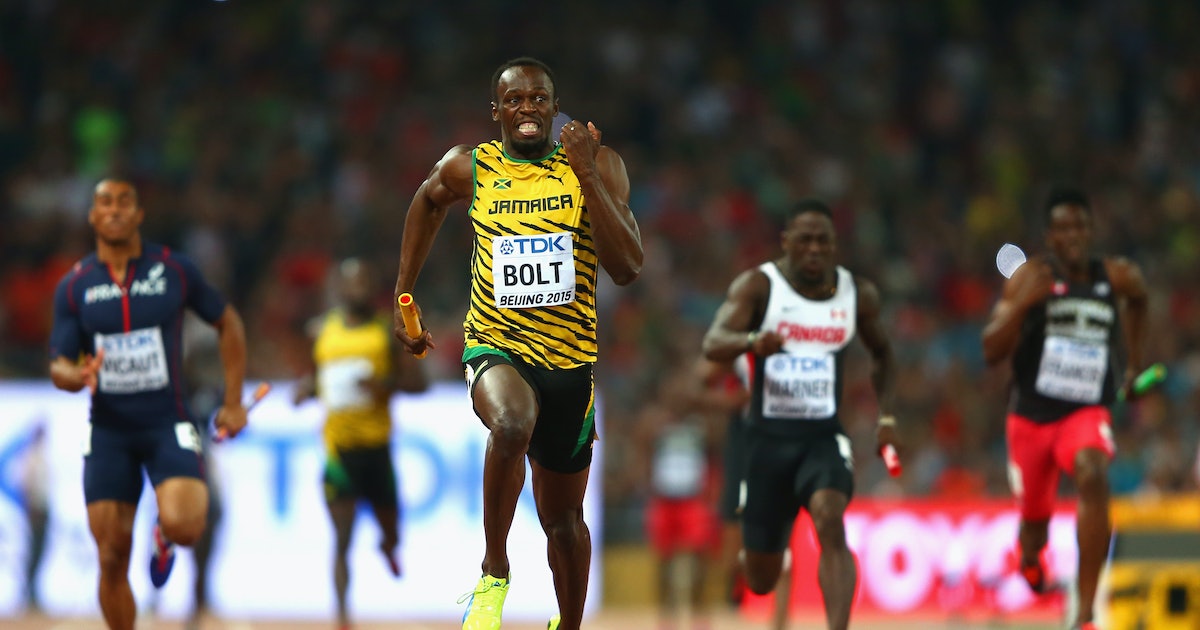Home>Misc>Featured>Which Muscle Fiber Type Is Used During High Intensity Interval Training


Featured
Which Muscle Fiber Type Is Used During High Intensity Interval Training
Modified: March 2, 2024
Discover which muscle fiber type is predominantly used during high intensity interval training (HIIT) and how it can impact your fitness results. Featured in-depth analysis and expert insights.
Introduction
High Intensity Interval Training (HIIT) has gained immense popularity in recent years as a quick and efficient way to improve cardiovascular fitness and burn calories. This type of exercise involves alternating short bursts of intense exercise with periods of rest or lower-intensity activity. HIIT workouts are known for their time-saving benefits and ability to provide excellent results in a short amount of time.
When it comes to understanding the science behind HIIT, it’s important to consider the role of muscle fiber types. The human body is composed of different types of muscle fibers, each with its own unique characteristics and functions. These muscle fibers can be classified into two primary types: type I (slow-twitch) and type II (fast-twitch).
In this article, we will dive deeper into the topic of muscle fiber types and explore which specific muscle fibers are primarily recruited during high intensity interval training. Understanding the role of muscle fibers in HIIT can provide valuable insights into the physiological adaptations that occur in response to this type of exercise.
Understanding Muscle Fiber Types
Before delving into the specific muscle fiber types involved in high intensity interval training (HIIT), it’s important to have a basic understanding of the two primary classifications of muscle fibers: type I (slow-twitch) and type II (fast-twitch).
Type I muscle fibers are often referred to as slow-twitch fibers. These fibers are characterized by their ability to contract for a prolonged period of time without fatigue. They are rich in mitochondria, which contribute to their high aerobic capacity. Type I fibers are responsible for endurance activities such as long-distance running and cycling. They generate energy through oxidative metabolism, making them highly efficient at utilizing oxygen to produce ATP.
On the other hand, type II muscle fibers are commonly known as fast-twitch fibers. They can generate high levels of force and contract rapidly, but they fatigue more quickly compared to type I fibers. Type II fibers are further divided into two subtypes: type IIa and type IIb.
Type IIa fibers possess characteristics of both type I and type IIb fibers. They have a higher anaerobic capacity compared to type I fibers and can sustain moderate intensity contractions for a decent duration. Type IIa fibers rely on both oxidative and glycolytic metabolic pathways to produce energy, making them suitable for activities such as sprinting and longer duration strength training.
Type IIb fibers, often referred to as fast-twitch glycolytic fibers, are characterized by their high anaerobic capacity. They are responsible for generating short, explosive bursts of power, making them crucial for activities that require maximal strength and speed. However, type IIb fibers fatigue rapidly and have a lower oxidative capacity compared to type I and type IIa fibers.
It’s worth noting that individuals can have different proportions of muscle fiber types, which can affect their athletic performance and exercise preferences. While genetics play a significant role in determining muscle fiber composition, training can also induce adaptations that can shift the proportion of muscle fiber types to better suit specific activities.
Now that we have a clearer understanding of the different muscle fiber types, let’s explore how these fibers are recruited during high intensity interval training (HIIT) and the implications for muscle fiber adaptation.
High Intensity Interval Training (HIIT)
High Intensity Interval Training (HIIT) is a form of cardiovascular exercise that involves short bursts of intense exercise followed by periods of rest or lower-intensity activity. This workout method has gained popularity due to its efficiency in burning calories and improving cardiovascular fitness.
HIIT workouts typically last between 10 to 30 minutes and can consist of various exercises such as sprints, cycling, jumping jacks, or burpees. The high-intensity intervals are performed at near-maximal effort, pushing the heart rate to its limits, while the recovery periods allow for brief rest to lower the heart rate before starting the next interval.
The key principle behind HIIT is to push the body to work at a higher intensity for short periods of time, stimulating both the aerobic and anaerobic systems. By incorporating brief, intense bursts of exercise, HIIT can improve cardiovascular endurance, boost metabolism, and enhance overall fitness levels.
Another advantage of HIIT is its potential for calorie burn even after the workout is complete. This effect, known as excess post-exercise oxygen consumption (EPOC), causes the body to continue burning calories at an elevated rate for several hours post-workout.
Moreover, HIIT workouts can be tailored to suit individual fitness levels and personal goals. The duration and intensity of the high-intensity intervals and the length of the recovery periods can be adjusted to accommodate beginner, intermediate, and advanced fitness levels.
While HIIT can be challenging, it offers a variety of benefits that make it an appealing option for people looking to maximize their workout efficiency and achieve their fitness goals in a shorter amount of time.
Now that we have a basic understanding of HIIT, let’s explore how different muscle fiber types are recruited during this type of training.
Muscle Fiber Recruitment during HIIT
During high intensity interval training (HIIT), both type I (slow-twitch) and type II (fast-twitch) muscle fibers are recruited to meet the demands of the exercise. The specific muscle fiber type recruitment can vary depending on the intensity, duration, and type of exercise performed during the workout.
At lower intensities and longer durations of exercise, such as steady-state cardio or long-distance running, type I muscle fibers are primarily recruited. These fibers have a high aerobic capacity and are well-suited for sustained contractions. They rely on oxidative metabolism, efficiently using oxygen to produce ATP for energy.
However, during high-intensity intervals in HIIT workouts, the demand for energy production exceeds what can be supplied aerobically. This triggers the recruitment of type II muscle fibers, specifically type IIa and type IIb fibers.
Type IIa fibers, also known as intermediate fibers, are recruited during moderately intense intervals. These fibers have a combination of aerobic and anaerobic characteristics, allowing them to sustain contractions for a decent duration while generating energy through both oxidative and glycolytic pathways.
For the most intense intervals in HIIT, type IIb fibers are recruited. These fast-twitch glycolytic fibers have a high anaerobic capacity and are responsible for generating short bursts of power. They rely heavily on the glycolytic metabolic pathway, which does not require oxygen to generate ATP for energy production.
It’s important to note that the recruitment of muscle fibers during HIIT is not exclusive to a single type. Instead, there is a continuum of recruitment depending on the intensity and duration of each interval. In general, as the intensity and duration of the intervals increase, the recruitment of type II muscle fibers becomes more prominent.
The recruitment of both type I and type II muscle fibers during HIIT is one of the factors that contribute to the effectiveness of this training method. By targeting a range of muscle fiber types, HIIT workouts stimulate various physiological adaptations and promote improvements in both aerobic and anaerobic fitness.
Type I (Slow-twitch) Muscle Fibers in HIIT
While high intensity interval training (HIIT) is commonly associated with the recruitment of fast-twitch muscle fibers, type I (slow-twitch) muscle fibers also play a significant role during this type of workout.
Type I muscle fibers are known for their endurance capabilities and efficient aerobic energy production. These fibers have a high density of mitochondria, which are responsible for generating ATP through oxidative metabolism. As a result, type I fibers are well-suited for sustaining contractions over long periods of time.
During the lower-intensity intervals or active recovery phases in HIIT, type I muscle fibers are predominantly recruited. These intervals allow for partial recovery and regeneration of ATP stores within the type I fibers, ensuring their proper functioning during subsequent high-intensity intervals.
Additionally, the inclusion of type I muscle fiber recruitment in HIIT has several benefits. Firstly, it helps to maintain muscle balance and prevent muscle imbalances that can potentially lead to injuries. By incorporating type I fibers, HIIT promotes overall muscular conditioning and enhances the body’s capacity for endurance activities.
Furthermore, type I muscle fibers have a role in enhancing overall workout performance and minimizing muscle fatigue. Regular HIIT training can lead to adaptations in type I fibers, such as improving their oxidative capacity and increasing mitochondrial density. These adaptations result in improved aerobic efficiency and delayed onset of muscle fatigue during subsequent workouts.
In summary, while HIIT is often associated with the recruitment of type II fast-twitch muscle fibers, the involvement of type I slow-twitch fibers is equally important. The recruitment and adaptation of both muscle fiber types contribute to the effectiveness of HIIT, promoting improvements in both aerobic and anaerobic fitness levels.
Type II (Fast-twitch) Muscle Fibers in HIIT
High intensity interval training (HIIT) is well-known for its ability to recruit and stimulate type II (fast-twitch) muscle fibers. These muscle fibers have a high capacity for generating force and power, making them essential for high-intensity activities.
During the intense intervals in HIIT workouts, type II muscle fibers, specifically type IIa and type IIb fibers, are recruited to meet the increased energy demands. The recruitment of type IIa fibers occurs during moderately intense intervals, while the most intense intervals elicit the recruitment of type IIb fibers.
Type IIa fibers possess characteristics of both type I and type IIb fibers. They are capable of sustaining contractions for a moderate duration and generate energy through both oxidative and glycolytic pathways. These fibers are well-suited for activities such as sprinting and longer duration strength training, where a combination of endurance and power is required.
Type IIb fibers, on the other hand, are fast-twitch glycolytic fibers that have a high anaerobic capacity. They excel at generating short bursts of maximal force and power. Although they fatigue quickly, their contribution is crucial for activities that demand maximum strength and speed, such as sprinting or explosive movements.
Through HIIT, the recruitment of type II muscle fibers is essential for promoting their adaptation and improving anaerobic performance. The intense nature of HIIT tasks these fibers to generate force and power, triggering physiological adaptations that enhance their strength and endurance capacities.
Regular HIIT training can lead to improvements in the oxidative capacity of type IIa fibers, increasing their resistance to fatigue and promoting efficient energy production. Additionally, the recruitment and stimulation of type IIb fibers in high-intensity intervals contribute to muscle growth and power development.
By targeting and challenging type II muscle fibers, HIIT workouts stimulate muscular adaptations that enhance anaerobic performance, explosive power, and overall muscle strength. These adaptations play a significant role in improving athletic performance and increasing the body’s capacity for intense physical activities.
Impact of HIIT on Muscle Fiber Adaptation
High Intensity Interval Training (HIIT) is a powerful stimulus for muscle fiber adaptation. The intense and dynamic nature of HIIT workouts triggers various physiological responses that lead to improvements in both type I (slow-twitch) and type II (fast-twitch) muscle fibers.
One of the key adaptations that occur in response to HIIT is the increase in mitochondrial density within muscle fibers. Mitochondria are responsible for energy production through oxidative metabolism. With regular HIIT training, the number and size of mitochondria within muscle cells increase, enhancing the aerobic capacity of both type I and type IIa fibers. This adaptation allows for improved energy production and efficiency, ultimately enhancing endurance abilities during high-intensity exercise.
Additionally, HIIT stimulates the activation of satellite cells, which are responsible for muscle repair and growth. These cells play a crucial role in muscle fiber hypertrophy, the increase in muscle size. As a result, HIIT can lead to increased muscle mass, contributing to overall strength and power development.
Furthermore, the recruitment and stimulation of type II muscle fibers during HIIT workouts can trigger an increase in protein synthesis and the activation of signaling pathways related to muscle growth. This leads to improvements in muscle fiber size, strength, and power output.
HIIT also promotes the release of growth hormone (GH) and testosterone, which are important hormones for muscle growth and repair. These hormones support muscle protein synthesis, stimulate cellular proliferation, and enhance overall muscle recovery and adaptation.
Another notable adaptation that occurs in response to HIIT is the improvement in muscle fiber efficiency. Both type I and type II muscle fibers become more efficient at utilizing energy substrates and generating force. This allows for better muscle performance and increased resistance to fatigue during high-intensity exercise.
Overall, HIIT elicits a wide range of physiological adaptations within muscle fibers, contributing to improved endurance, increased muscle size and strength, and enhanced overall exercise performance. The combination of aerobic and anaerobic stimuli provided by HIIT triggers these adaptations, making it an efficient and effective training method for individuals looking to optimize their fitness levels.
Conclusion
High Intensity Interval Training (HIIT) is a popular and efficient exercise method that offers numerous benefits for improving cardiovascular fitness and enhancing muscle adaptation. By understanding the role of muscle fiber types during HIIT, we can gain insights into the physiological responses and adaptations that occur as a result of this type of training.
During HIIT, both type I (slow-twitch) and type II (fast-twitch) muscle fibers are recruited. Type I fibers, known for their endurance capabilities, are primarily recruited during lower-intensity intervals or active recovery phases. On the other hand, the higher intensity intervals in HIIT stimulate the recruitment of type IIa and type IIb muscle fibers, which are responsible for generating force and power.
Through HIIT, a range of adaptations occur within muscle fibers. These include improvements in mitochondrial density, muscle protein synthesis, muscle fiber size, and overall muscle efficiency. These adaptations contribute to enhanced aerobic and anaerobic capacity, increased strength, improved endurance, and better overall exercise performance.
It’s important to note that individual variations in muscle fiber composition may influence an individual’s response to HIIT. Genetic factors play a role in determining our muscle fiber composition, and this can impact our performance and potential for adaptation during HIIT.
In conclusion, HIIT is a highly effective training method for improving cardiovascular fitness, burning calories, and promoting muscle adaptation. By targeting both type I and type II muscle fibers, HIIT provides a comprehensive and efficient workout experience. Whether you want to enhance your endurance, increase your strength, or improve your overall fitness level, incorporating HIIT into your exercise routine can yield impressive results.









